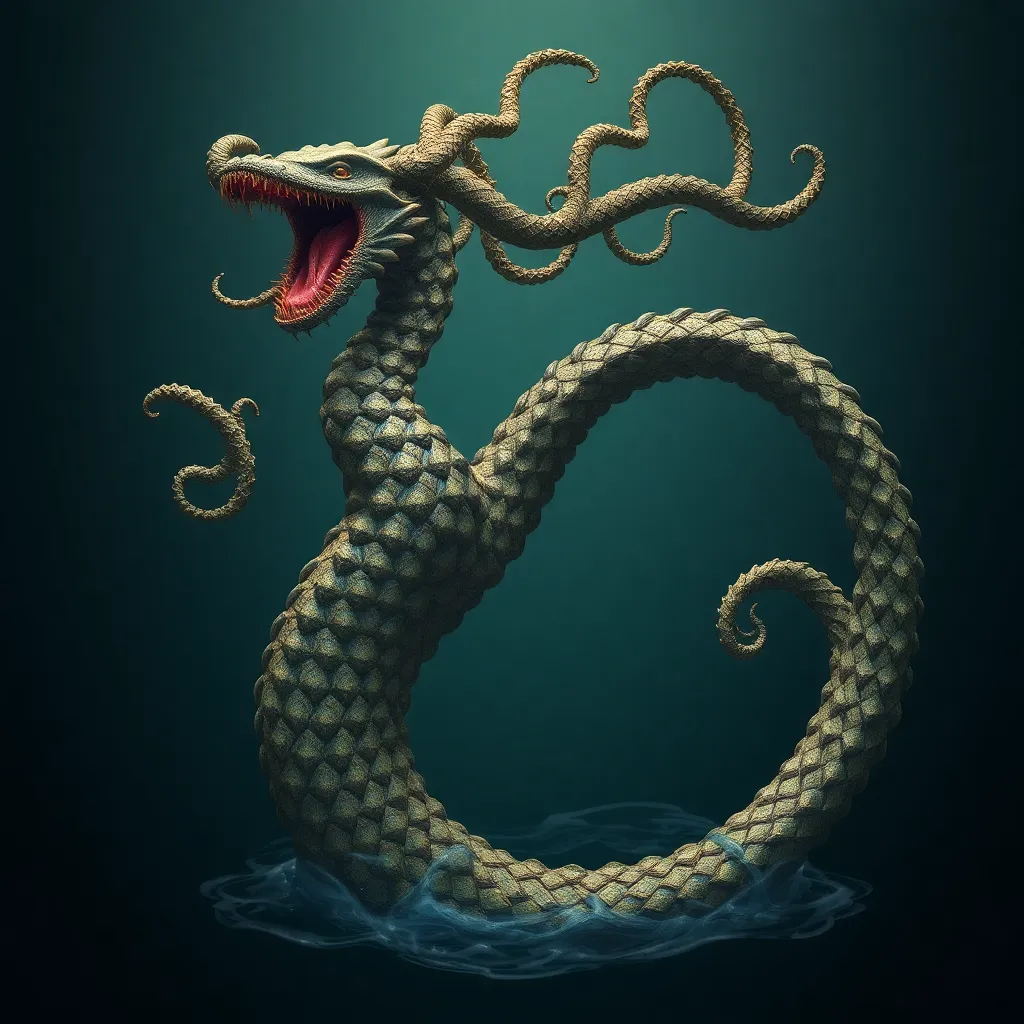The Hydra’s Image: A Study of the Monster’s Artistic Representations in Ancient Greece
I. Introduction
The Hydra, a fearsome creature from Greek mythology, is often depicted as a multi-headed serpent that grows two heads for each one that is severed. This chilling image has captivated the imagination of artists and storytellers throughout the ages. The significance of the Hydra in ancient Greek art is profound, serving not only as a subject of fascination but also as a symbol of the struggles between man and monstrous forces. This study aims to explore the various artistic representations of the Hydra in ancient Greece, examining how these depictions reflect the cultural values and mythological narratives of the time.
II. Mythological Background of the Hydra
The origins of the Hydra can be traced back to the mythological traditions of ancient Greece. According to legend, the Hydra was born from Typhon and Echidna, making it a sibling to various other monsters, including the Chimera and the Sphinx. Its most notable characteristics include its regenerative ability—where cutting off one head results in the growth of two—and its association with the marshy waters of Lerna, where it resided.
The Hydra plays a crucial role in the Twelve Labors of Heracles, specifically as the second labor assigned to him. Heracles was tasked with slaying the creature, a feat that required not only strength but also cleverness, as he had to enlist the help of his nephew Iolaus to cauterize the necks after decapitation to prevent the heads from regrowing. This labor symbolizes the struggle against chaos and the triumph of order, themes prevalent in Greek mythology.
Symbolically, the Hydra represents challenges and fears that seem insurmountable. The themes of regeneration and resilience embedded in the creature’s nature often resonate with human experiences of overcoming adversity.
III. Artistic Representations of the Hydra
Ancient Greek art is rich with depictions of the Hydra across various forms including pottery, sculpture, and frescoes. Each art form presents unique interpretations and styles that reflect the cultural and historical contexts in which they were created. This section will provide an overview of these different art forms, examine notable pieces depicting the Hydra, and discuss the evolution of the creature’s image through the various periods of Greek art.
A. Overview of different art forms
- Pottery: Vases, amphorae, and kraters often featured scenes from mythology, including the Hydra.
- Sculpture: Statues and reliefs captured the dynamic scenes of Heracles battling the Hydra.
- Frescoes: Wall paintings illustrated the mythological narratives in domestic and public spaces.
B. Examination of notable pieces depicting the Hydra
Among the myriad artworks, the following stand out:
- Panathenaic amphora: This large vase features intricate scenes of Heracles fighting the Hydra, showcasing the hero’s struggle against the beast.
- Red-figure vase by the Pan Painter: A detailed depiction of the Hydra with Heracles and Iolaus illustrates the teamwork required to defeat the monster.
- Relief from the Temple of Apollo: This relief captures the moment of victory, highlighting the significance of the Hydra in the context of Heracles’ labors.
C. Evolution of the Hydra’s image through various periods
Over time, the representation of the Hydra has evolved. Initially depicted in a more abstract form during the Geometric period, the creature’s image became increasingly detailed and realistic during the Classical period. By the Hellenistic period, artists began to emphasize the emotional intensity and drama of the scenes, reflecting a more human-centric approach to mythology.
IV. The Hydra in Ancient Greek Pottery
Ancient Greek pottery remains one of the richest sources for understanding the artistic representation of the Hydra. Two primary techniques were utilized: black-figure and red-figure pottery.
A. Analysis of black-figure and red-figure techniques
Black-figure pottery, characterized by figures painted in a black slip, was predominant prior to the 6th century BCE. Artists would incise details into the black figures, allowing the red clay to show through. In contrast, red-figure pottery emerged later, allowing for greater detail and flexibility in depiction.
B. Iconography: how artists depicted the Hydra’s features
Artists typically depicted the Hydra with multiple heads, often shown in various states of battle. The creature was often illustrated with a fierce expression, emphasizing its danger. The heads were sometimes exaggerated in size to highlight the monstrous nature of the Hydra.
C. Case studies of specific vases and their interpretations
One notable example is the “Heracles and the Hydra” amphora, which shows Heracles wielding a sword against the creature. The dynamic composition and the interplay of figures convey the tension of the battle, making it a powerful narrative piece. Another example is a red-figure krater that depicts Iolaus cauterizing the necks, illustrating the collaborative effort required to defeat the Hydra.
V. Sculptural Representations of the Hydra
Sculpture played a significant role in shaping the public perception of the Hydra, often highlighting the drama of its mythological battles.
A. Examination of notable sculptures featuring the Hydra
Notable sculptures include reliefs from temples and large freestanding statues. The “Hercules and the Hydra” statue, for example, captures the moment of victory, emphasizing Heracles’ strength and cunning.
B. Discussion of stylistic variations and artistic techniques
The stylistic approaches to sculpture varied from the rigid forms of the Archaic period to the more fluid and expressive styles of the Hellenistic period. This evolution reflects broader changes in artistic techniques and the cultural significance of heroic narratives.
C. The impact of sculpture on the perception of the Hydra
Sculptural representations helped to solidify the Hydra’s image as a formidable adversary in the public consciousness, serving both as a cautionary tale and as an embodiment of chaos to be overcome.
VI. The Hydra in Mosaics and Frescoes
Mosaics and frescoes provided a vibrant medium for depicting the Hydra, often set against elaborate backgrounds that added context to the mythological scenes.
A. Overview of the use of the Hydra in wall art
Mosaics often featured intricate designs that highlighted the multifaceted nature of the Hydra. Frescoes, used in both public and private spaces, often served to tell stories of triumph and heroism.
B. Contextual significance of these representations in public and private spaces
In public spaces, representations of the Hydra conveyed messages of bravery and the triumph of good over evil. In private homes, they served as reminders of the trials one must face in life.
C. Analysis of specific mosaics and their narrative elements
One prominent example is the “Battle of Heracles and the Hydra” mosaic found in a villa in Pompeii. The mosaic intricately details the battle with a focus on the expressions of the figures, showcasing the intense struggle between Heracles and the Hydra.
VII. The Hydra’s Legacy in Art and Culture
The influence of the Hydra extends beyond ancient Greece, impacting later artistic movements and contemporary interpretations.
A. Influence of the Hydra on later artistic movements
The Hydra has inspired countless artists throughout history, from the Renaissance to modern art, where its image has been reinterpreted in various styles. The themes of chaos and resilience continue to resonate, making the Hydra a relevant symbol across cultures.
B. The Hydra’s symbolism in contemporary interpretations
In contemporary culture, the Hydra often symbolizes multi-faceted challenges, reflecting the complexities of modern life. The phrase “cut off one head and two grow back” has entered popular language, illustrating the idea of persistent challenges.
C. Comparison of ancient and modern representations
While ancient representations focus on the mythological narrative and heroism, modern interpretations often delve into psychological and existential themes, showcasing the Hydra as a metaphor for internal struggles.
VIII. Conclusion
This study has explored the multifaceted representations of the Hydra in ancient Greek art, highlighting its significance in mythology and cultural narratives. The Hydra’s image has evolved over time, reflecting changing artistic styles and societal values. Its enduring legacy in both ancient and modern contexts emphasizes the timeless nature of its symbolism, representing the battles we face against chaos and adversity.</p




